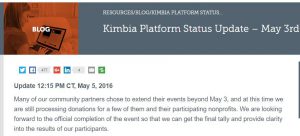 Give Local Day is yet one more giving day in a growing list of events designed to encourage more philanthropy and get individuals involved in connecting to more charities. In Minnesota, Give to the Max Day has become a staple of most fund-development calendars. The newer #GivingTuesday focuses on the Tuesday following Thanksgiving as a means of keeping the giving spirit alive during the normal holiday shopping rush. Many, many more such days are underway and many are growing.
Give Local Day is yet one more giving day in a growing list of events designed to encourage more philanthropy and get individuals involved in connecting to more charities. In Minnesota, Give to the Max Day has become a staple of most fund-development calendars. The newer #GivingTuesday focuses on the Tuesday following Thanksgiving as a means of keeping the giving spirit alive during the normal holiday shopping rush. Many, many more such days are underway and many are growing.
And becoming victims of their own success. Kimbia just experienced their own major technical glitch on Give Local day, May 3, and the fallout is still in process.
Early on in Give to the Max Day history, technical problems with the service frustrated many nonprofits, and prompted GiveMN.org to change service providers (to Kimbia, in fact) to avoid a repeat. The problem is easily understood by anyone who has ever been in rush hour traffic. It’s not a problem to move thousands of cars through an interstate highway. The problem occurs when all of the cars want to go at the same time. A giving day generates excitement and traffic, but most giving days concentrate traffic on a single road – or in the case of #GivingTuesday – several major thoroughfares.
There are many ways to process a gift to a nonprofit, but on the specific giving day there are usually incentives to use only one provider. If you don’t give through Site X, your donation won’t be counted on the leaderboard, or won’t be eligible for a potential match, or won’t …. fill in the blank. Days like this crunch 360 some days of traffic into just a few, which would be okay if we used every available side street and alley and counted those just like we count the big roads.
Kimbia is now the latest victim of too much traffic melting (perhaps literally?) servers. It’s time to reconsider the “only one way to give” mentality of a giving day. Let’s aggregate all the resources and allow charities to select their own method of tracking donations to be shared with a central list. Smaller donor processors (CommitChange, etc…) could then take some of the load off the larger servers, and distribute the work. Distributed (or federated, in this case) work is, after all, the whole point of the internet. If all the giving day sites have to do is manage data totals, rather than actually running all the secure donation processes, then charities would likely get a better experience for their donors, and philanthropy boosters will get a better total of what is actually happening rather than just the segment that is willing and able to successfully give in that rush-hour jam.
Smart nonprofits will want to be sure to follow the advice of Kivi Leroux Miller in the interim. Rather than telling donors to go directly to the giving day site, use a page redirect from the charity’s own site. This way, it’s possible change that direction on the fly if something goes wrong. Contact us with questions about managing the Plan B for the next giving day meltdown.

Pingback: The Heroes and Villains of the Give Local America Story #GiveDayLessons | Kivi's Nonprofit Communications Blog